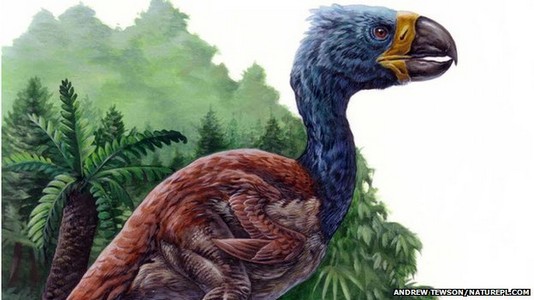Footprints believed to have been made by the giant bird Diatryma indicate that it was a “gentle herbivore” and not a fierce carnivore, scientists say.

A team of researchers from Washington, US, examined tracks uncovered in a landslide in 2009.
Previous investigations have suggested the giant bird was a carnivorous predator or scavenger.
But the absence of raptor-like claws in the footprints supports the theory that Diatryma was not a meat-eater.
Measuring 7ft (2.13m) tall and with a huge head and beak, the giant flightless bird Diatryma(believed by some experts to belong to the genus Gastornis) is commonly portrayed as a fierce predator in both scientific works and popular media.
The animal is frequently thought as “the bird that replaced dinosaurs as the top predator”, said geologist and team member George Mustoe, from Western Washington University in Bellingham, US.
“Let’s be honest: scary, fierce meat-eaters attract a lot more attention than gentle herbivores.”
The study, published in the journalPaleontology, analysed a set of footprints made 55.8 to 48.6 million years ago in the Lower Eocene. Preserved in sandstone, the prints formed part of the Chuckanut Formation in northwest Washington, US.
The team concluded that the multiple, well-preserved tracks were most likely to have been made by Diatryma.
That would make them the only known footprints left behind by this giant bird, and they provide new evidence about what it ate.
“[The tracks] clearly show that the animals did not have long talons, but rather short toenails,” said David Tucker, from Western Washington University, who also worked on the study.
“This argues against an animal that catches prey and uses claws to hold it down. Carnivorous birds all have sharp, long talons.”
Early palaeontologists studying Diatryma fossils concluded that the giant bird was a predator because of its size, huge head and large beak.
The first Diatryma skeleton found in the US was preserved alongside bones of tiny horses and other small mammals. Some scientists posited that these must have been the bird’s prey, explained Mr Mustoe.
However, Diatryma also had relatively short legs, leading others to suggest it could not have run fast enough to capture prey, and was therefore a herbivore.
Further analysis has shown that the bird did not have a hook on the end of its beak – a feature found in all raptors which helps them to hold prey and tear into carcasses.
The research team’s conclusion that the animal did not have talons “[adds] ammunition to the herbivory diet hypothesis”, Mr Tucker told BBC Nature.
“A more likely scenario [than being a carnivore] would be a gentle Diatryma that used its beak to harvest foliage, fruits, and seeds from the subtropical forests that it inhabited,” Mr Mustoe added.
The team believe that the similarities ofDiatryma to those of the carnivorous South American Phorusracids or “terror birds” led early palaeontologists to assume that the two were ecologically similar.
According to the study: “The common belief that Diatryma… was likewise a carnivore is more a result of guilt by association than actual anatomical evidence”.





